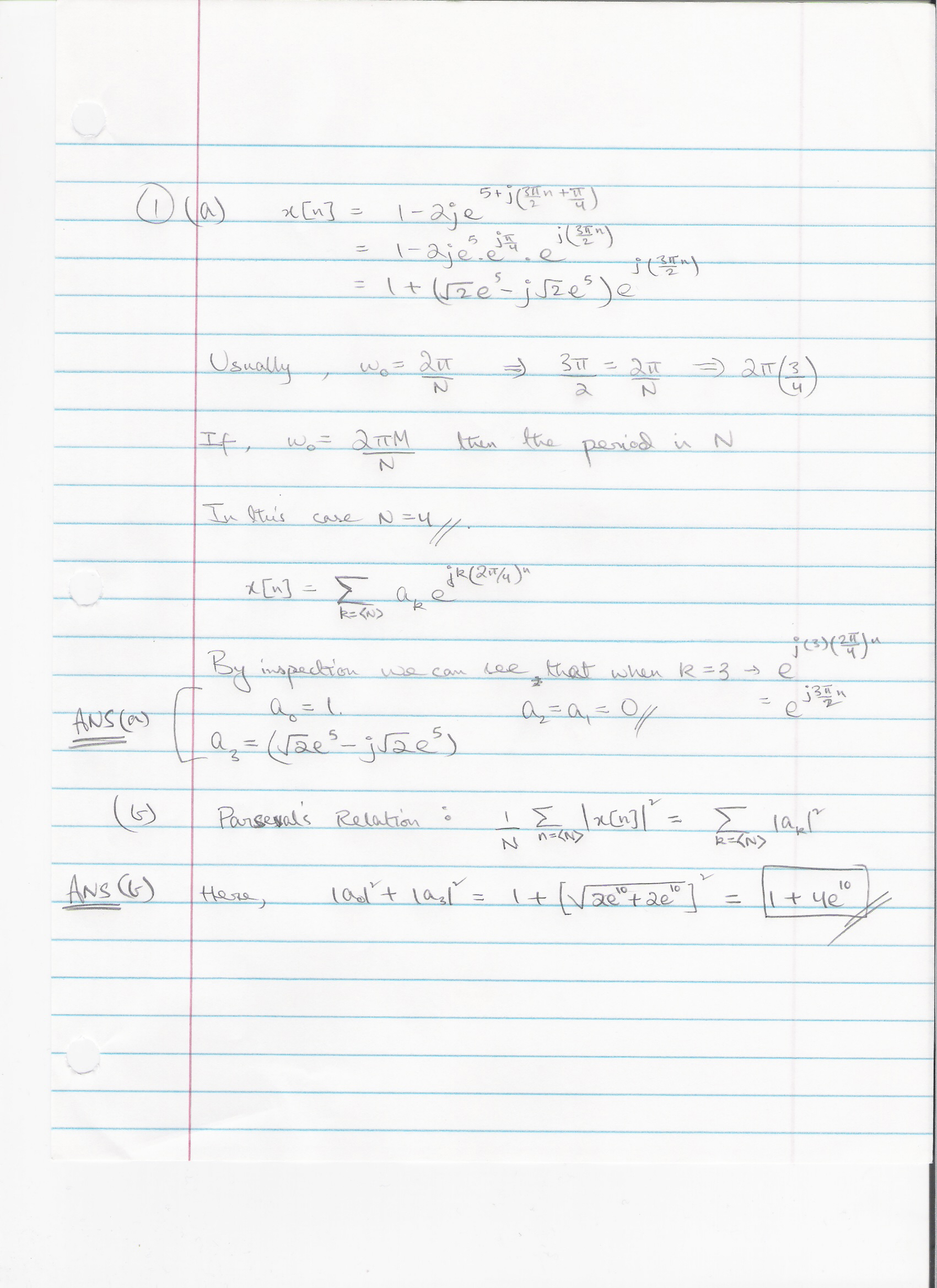m |
|||
| Line 99: | Line 99: | ||
[[Category:ECE 301 San Summer 2008]] | [[Category:ECE 301 San Summer 2008]] | ||
| + | [[Image:Question1_Old Kiwi.jpg]] | ||
Revision as of 14:24, 21 July 2008
Read the discussion page using the discussion tab above. (Aung - 11:09 pm 07/18/08)
Problems
1)a)If a discrete time singal x[n] is periodic with period N, then the Fourier series coefficients $ a_k $ of the signal x[n] is also periodic with period N. For the periodic signal x[n], find the values of $ a_0,a_1,...,a_{N-1}. $ Express your answer in a + jb form.
$ x[n]=1 - 2je^{5+j(3\pi/2*n+\pi/4)} $
1)b)Evaluate the value of $ (1/N)*\sum_{n=<N>}|x[n]|^2 $ for the signal x[n] given in part (a).
2)a)Let's consider a continuous-time periodic signal x(t) with period T = 5 whose non-zero Fourier series coefficients $ a_k $ are given by
$ a_1=a_{-1}=2,a_3=a*_{-3}=4j $
If x(t) is the input to a particular LTI system characterized by the frequency response
$ H(j\omega)=1/(3+j\omega) $
then the output is y(t).
Is the output signal y(t) periodic? Answer YES or NO only.
2)b)If your answer to part (a) is YES, then let $ b_k $ be the fourier series coefficients of y(t) and find the values of $ b_k $. You need not simplify the complex numbers. If your answer to part (a) is NO, then explain why y(t) is not periodic.
Solutions
1)a) Change the equation to look like a forier series. $ x[n]=1-2je^{5+j(3\pi/2*n+\pi/4)}= $ $ x[n]=1 - 2je^{\pi/4}e^{5}e^{j(3\pi/2)*n}= $ $ x[n]=1 + (\sqrt{2}e^{5} - j\sqrt{2}e^5)e^{j(3\pi/2*n)} $
find the period N. $ \omega_0=3\pi/2 $. $ P=2\pi/\omega_0=4/3 $. The LCM of 1 and 4/3 is 12. Therefore N=12
Choose values of $ a_k $ that match the forier series repersentation of x[n]
$ x[n]=\sum_{k=<n>}^{}a_ke^{jk(2\pi/12)n} $
$ a_0=1 $
$ a_9=\sqrt{2}e^{5} - j\sqrt{2}e^5 $
1)b) Some energy therom states that: $ \sum_{n=<N>}|x[n]|^2=N*sum_{k=<N>}|a_k|^2 $
Therefore:
$ (1/N)*\sum_{n=<N>}|x[n]|^2=\sum_{k=<N>}|a_k|^2 $
$ (1/N)*\sum_{n=<N>}|x[n]|^2=1^2+|(-2je^{\pi/4}e^{5})|^2=1 + e^{10} $
$ (1/N)*\sum_{n=<N>}|x[n]|^2=1 + e^{10} $
--Krtownse 15:53, 18 July 2008 (EDT)
2)a) YES
2)b)First thing: state $ a_k $ clearly:
$ a_{-3}=-4j $
$ a_{-1}=2 $
$ a_{1}=2 $
$ a_{3}=4j $
Periodic signals have the fourier transform of $ X(e^{jw})=\sum_{k=-\infty}^{infty}2\pi a_k\delta(\omega-k\omega_0) $
T=5
$ w_0=2\pi/T=2\pi/5 $
y(t)=x(t)*h(t) (convulution)
$ Y(e^{j\omega})=X(e^{j\omega})H(e^{j\omega}) $
$ Y(e^{j\omega})=\sum_{k=-\infty}^{infty}2\pi a_k\delta(\omega-k\omega_0)(1/(3+j/omega)) $
$ Y(e^{j\omega})=\sum_{k=-\infty}^{infty}2\pi a_k(1/(3+jk/omega_0)\delta(\omega-k\omega_0)) $
$ Y(e^{j\omega})=\sum_{k=-\infty}^{infty}2\pi(a_k/(3+jk2/pi/5))\delta(\omega-k\omega_0)) $
notice $ b_k=a_k/(3+jk2/pi/5) $
$ b_{-3}=-4j/(3-j6/pi/5) $
$ b_{-1}=2/(3-j2/pi/5) $
$ b_{1}=2/(3+j2/pi/5) $
$ b_{3}=4j/(3+j6/pi/5 $
$ b_k=0 $ for all other k
--Krtownse 19:55, 18 July 2008 (EDT)

